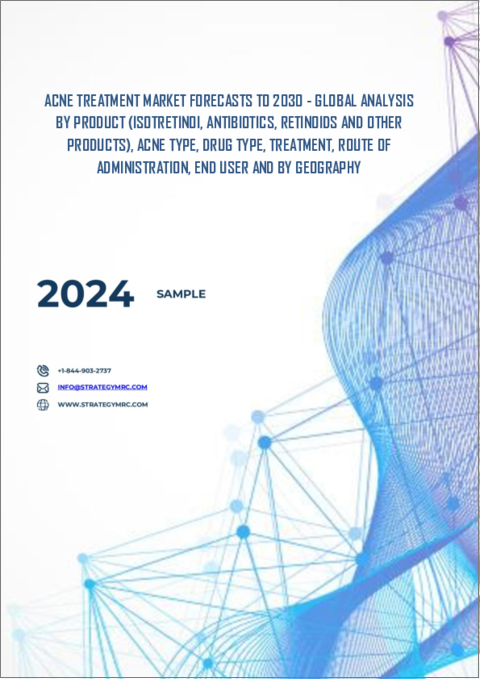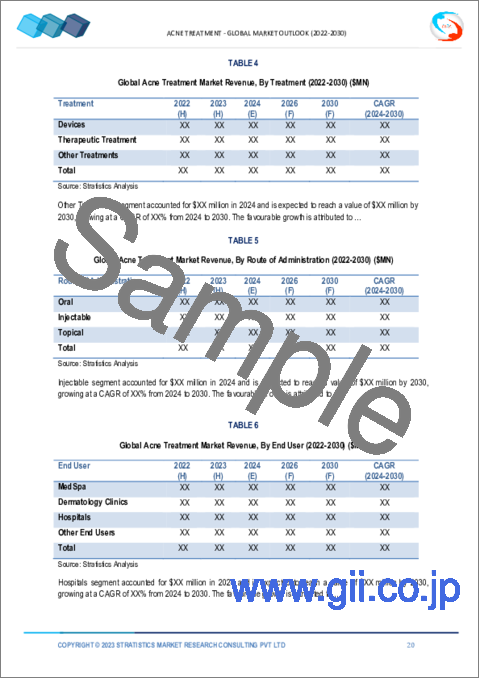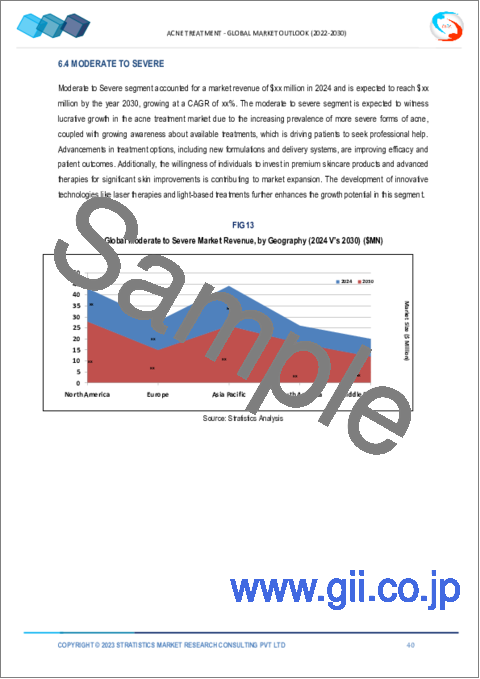|
|
市場調査レポート
商品コード
1403412
ニキビ治療市場の2030年までの予測:製品別、ニキビタイプ別、薬剤タイプ別、治療法別、投与経路別、エンドユーザー別、地域別の世界分析Acne Treatment Market Forecasts to 2030 - Global Analysis By Product (Isotretinoi, Antibiotics, Retinoids and Other Products), Acne Type, Drug Type, Treatment, Route of Administration, End User and By Geography |
||||||
カスタマイズ可能
|
|||||||
| ニキビ治療市場の2030年までの予測:製品別、ニキビタイプ別、薬剤タイプ別、治療法別、投与経路別、エンドユーザー別、地域別の世界分析 |
|
出版日: 2024年01月01日
発行: Stratistics Market Research Consulting
ページ情報: 英文 200+ Pages
納期: 2~3営業日
|
全表示
- 概要
- 図表
- 目次
Stratistics MRCによると、世界のニキビ治療市場は2023年に111億米ドルを占め、予測期間中にCAGR 7.1%で成長し、2030年には180億米ドルに達すると予想されています。
毛包を含む皮膚の毛穴や開口部の詰まりは、皮膚関連疾患であるにきびの原因です。ティーンエイジャーと成人初期の人々が、この配置を示す主要な層です。これは、年齢に関係なくすべての肌タイプに影響を及ぼす、非常に一般的な皮膚疾患です。この種の皮膚疾患の治療には、抗生物質とレチノイドが使用されます。このような皮膚症状を治療することで期待される効果が得られるという確証はないにもかかわらず、この業界はその美容的価値から、長い間この分野を支配してきました。
米国立生物工学情報センター(NCBI)によると、2022年のにきびの有病率は世界人口の9.4%に影響しました。これは世界で8番目に多い疾患です。
成長促進要因:にきびの有病率の増加
皮膚疾患は多くの人々に影響を与えています。レチノイド、イソトレチノイド、経口および局所抗生物質など、治療に使用される数多くの製品の出現により、世界の一般大衆は、にきび製品および利用しやすい治療法の選択肢に対する認識が高まっています。そのため、患者の認知度の向上が市場の拡大を促進すると予想されます。また、対象者の興味をそそる効果的な製品マーケティングも、市場拡大を促進する重要な要素です。
成長抑制要因:製品の安全性に関する懸念
ニキビ治療薬には、投与量や投与方法によってさまざまな副作用が生じる可能性があります。皮膚の炎症と乾燥は、外用ニキビ治療薬で最も頻度の高い副作用です。内服薬では、より重篤な副作用の可能性があります。抗生物質は吐き気や嘔吐、めまいや軽い頭痛を引き起こすことがあります。ニキビ治療薬にまつわる安全性への懸念は、市場拡大の妨げになると予想されます。
機会:認知度の向上
低侵襲の美容治療に対する需要が高まっています。皮膚科医は、外科的な治療よりも、局所的な治療や侵襲性の低い手技で皮膚の状態に対処したいと考えています。より良い意思決定、患者と医師のつながりの改善、十分に文書化された処置の結果として、顔や皮膚関連の問題に関連した治療のニーズが高まっています。このため、より痛みの少ない美容コンビネーション治療法の使用が促されています。
脅威:高額な治療費
効果的なニキビ治療は、特に処方薬やレーザー治療のような処置の場合、時として高額になることがあります。これは、資力の乏しい人や保険に加入していない人にとっては深刻な欠点です。ニキビの治療は、一度だけの出費では済まないかもしれないです。いくつかの治療法では、定期的なメンテナンスやフォローアップの予約が必要なため、全体的な費用がかさみます。これらの要因が市場の成長を妨げています。
COVID-19の影響
世界中で治療を求める人が減少したため、ニキビ治療薬の増加は流行によって鈍化しました。業界の大手企業はCOVID-19の影響で大幅な減収となった。医薬品の売上は、製造の縮小、ヘルスケア支出の再分配、サプライチェーンの寸断、皮膚科クリニックの閉鎖、その他の問題によっても影響を受けた。医療用フェイスマスクの長期使用に関連したニキビ発生の増加は、医薬品需要をさらに押し上げる要因となった。
予測期間中、治療機器分野が最大となる見込み
予測期間中、治療機器分野が最大となる見込みです。ニキビ治療のための治療用ガジェットの開発が、この業界の拡大を推進しています。以前のニキビエピソードによる傷跡を目立たなくすることが、ニキビ跡のレーザー治療の目的です。継続的な光治療を皮膚の真皮層に適用することで、瘢痕組織を破壊し、損傷した組織の代わりとなる新しい健康な皮膚細胞の成長を促進します。
予測期間中、レチノイド分野が最も高いCAGRが見込まれる
レチノイド分野は、予測期間中に最も高いCAGRが見込まれます。レチノイドは現在、開いた毛穴に詰まった余分な皮脂やホコリを除去するために広く使用されています。この方法は安全で悪影響が少ないとされているため、大きな市場分野となっています。ニキビの主な原因である古い角質が毛穴をふさぐのを食い止めることで機能します。細胞のターンオーバーを促すことで、レチノイドの産生が毛穴の詰まりを防ぎます。
最大のシェアを持つ地域
予測期間中、北米が最大の市場シェアを占めると予測されるが、これは同地域でニキビ患者が増加していることと、美容に関する消費者の問題が増加していることによる。同地域の主要企業による新製品のイントロダクションや、患者人口の顕著な増加により、市場は成長します。革新的な治療法やソリューションがより頻繁に使用されるようになるにつれて、市場シェアはより大きなボリュームに拡大すると思われます。
CAGRが最も高い地域
アジア太平洋地域は、市場参入企業の増加に加え、複数の医薬品に対する国民の意識が高まっていることから、予測期間中に最も高いCAGRを維持すると予測されます。きれいな肌を実現するために作られた様々な化粧品に対する最大の顧客基盤はこの地域にあります。気候のため、この地域では色素沈着も重要な問題として認識されています。さらに、予測期間中、消費者の医薬品使用の増加によって成長が促進されるであろう。
無料カスタマイズサービス
本レポートをご購読のお客様には、以下の無料カスタマイズオプションのいずれかをご利用いただけます。
- 企業プロファイル
- 追加市場企業の包括的プロファイリング(3社まで)
- 主要企業のSWOT分析(3社まで)
- 地域セグメンテーション
- 顧客の関心に応じた主要国の市場推計・予測・CAGR(注:フィージビリティチェックによる)
- 競合ベンチマーキング
- 製品ポートフォリオ、地理的プレゼンス、戦略的提携に基づく主要企業のベンチマーキング
目次
第1章 エグゼクティブサマリー
第2章 序文
- 概要
- ステークホルダー
- 調査範囲
- 調査手法
- データマイニング
- データ分析
- データ検証
- 調査アプローチ
- 調査ソース
- 1次調査ソース
- 2次調査ソース
- 前提条件
第3章 市場動向分析
- 促進要因
- 抑制要因
- 機会
- 脅威
- 製品分析
- エンドユーザー分析
- 新興市場
- 新型コロナウイルス感染症(COVID-19)の影響
第4章 ポーターのファイブフォース分析
- 供給企業の交渉力
- 買い手の交渉力
- 代替品の脅威
- 新規参入業者の脅威
- 企業間の競合関係
第5章 世界のニキビ治療市場:製品別
- イソトレチノイド
- 抗生物質
- レチノイド
- その他の製品
第6章 世界のニキビ治療市場:ニキビタイプ別
- 中等度
- 軽度
- 中等度から重度
第7章 世界のニキビ治療市場:薬剤タイプ別
- 処方箋
- 店頭販売(OTC)
第8章 世界のニキビ治療市場:治療法別
- デバイス
- 高周波デバイス
- レーザー装置
- 治療的処置
- 抗炎症薬
- ケミカルピーリング
- ホルモン剤
- レチノイド療法
- 抗生物質
- その他の治療法
第9章 世界のニキビ治療市場:投与経路別
- 経口
- 注射可能
- 局所
第10章 世界のニキビ治療市場:エンドユーザー別
- メッドスパ
- 皮膚科クリニック
- 病院
- その他のエンドユーザー
第11章 世界のニキビ治療市場:地域別
- 北米
- 米国
- カナダ
- メキシコ
- 欧州
- ドイツ
- 英国
- イタリア
- フランス
- スペイン
- その他欧州
- アジア太平洋地域
- 日本
- 中国
- インド
- オーストラリア
- ニュージーランド
- 韓国
- その他アジア太平洋地域
- 南米
- アルゼンチン
- ブラジル
- チリ
- その他南米
- 中東とアフリカ
- サウジアラビア
- アラブ首長国連邦
- カタール
- 南アフリカ
- その他中東とアフリカ
第12章 主な発展
- 契約、パートナーシップ、コラボレーション、合弁事業
- 買収と合併
- 新製品の発売
- 事業拡大
- その他の主要戦略
第13章 企業プロファイル
- Johnson & Johnson Services, Inc.
- Teva Pharmaceutical Industries Ltd.
- Leo Pharma A/S
- Stiefel Laboratories, Inc.
- Bayer AG
- Roche Holding AG
- Bausch Health Companies Inc.
- Galderma Laboratories
- Hoffman La Roche Ltd
- Pfizer Inc.
- Valeant Pharmaceutical International, Inc.
- GlaxoSmithKline Plc.
- Cutera Inc.
- Vyne Therapeutics Inc.
- Botanix Pharmaceuticals
- ABBVIE INC.
- Candela Corporation
- Almirall, S.A.
List of Tables
- Table 1 Global Acne Treatment Market Outlook, By Region (2021-2030) ($MN)
- Table 2 Global Acne Treatment Market Outlook, By Product (2021-2030) ($MN)
- Table 3 Global Acne Treatment Market Outlook, By Isotretinoi (2021-2030) ($MN)
- Table 4 Global Acne Treatment Market Outlook, By Antibiotics (2021-2030) ($MN)
- Table 5 Global Acne Treatment Market Outlook, By Retinoids (2021-2030) ($MN)
- Table 6 Global Acne Treatment Market Outlook, By Other Products (2021-2030) ($MN)
- Table 7 Global Acne Treatment Market Outlook, By Acne Type (2021-2030) ($MN)
- Table 8 Global Acne Treatment Market Outlook, By Moderate (2021-2030) ($MN)
- Table 9 Global Acne Treatment Market Outlook, By Mild (2021-2030) ($MN)
- Table 10 Global Acne Treatment Market Outlook, By Moderate to Severe (2021-2030) ($MN)
- Table 11 Global Acne Treatment Market Outlook, By Drug Type (2021-2030) ($MN)
- Table 12 Global Acne Treatment Market Outlook, By Prescription (2021-2030) ($MN)
- Table 13 Global Acne Treatment Market Outlook, By Over the Counter (OTC) (2021-2030) ($MN)
- Table 14 Global Acne Treatment Market Outlook, By Treatment (2021-2030) ($MN)
- Table 15 Global Acne Treatment Market Outlook, By Devices (2021-2030) ($MN)
- Table 16 Global Acne Treatment Market Outlook, By Radio frequency Devices (2021-2030) ($MN)
- Table 17 Global Acne Treatment Market Outlook, By Laser Devices (2021-2030) ($MN)
- Table 18 Global Acne Treatment Market Outlook, By Therapeutic Treatment (2021-2030) ($MN)
- Table 19 Global Acne Treatment Market Outlook, By Anti-inflammatory Drugs (2021-2030) ($MN)
- Table 20 Global Acne Treatment Market Outlook, By Chemical Peels (2021-2030) ($MN)
- Table 21 Global Acne Treatment Market Outlook, By Hormonal Drugs (2021-2030) ($MN)
- Table 22 Global Acne Treatment Market Outlook, By Retinoid Therapy (2021-2030) ($MN)
- Table 23 Global Acne Treatment Market Outlook, By Antibiotics (2021-2030) ($MN)
- Table 24 Global Acne Treatment Market Outlook, By Other Treatments (2021-2030) ($MN)
- Table 25 Global Acne Treatment Market Outlook, By Route of Administration (2021-2030) ($MN)
- Table 26 Global Acne Treatment Market Outlook, By Oral (2021-2030) ($MN)
- Table 27 Global Acne Treatment Market Outlook, By Injectable (2021-2030) ($MN)
- Table 28 Global Acne Treatment Market Outlook, By Topical (2021-2030) ($MN)
- Table 29 Global Acne Treatment Market Outlook, By End User (2021-2030) ($MN)
- Table 30 Global Acne Treatment Market Outlook, By MedSpa (2021-2030) ($MN)
- Table 31 Global Acne Treatment Market Outlook, By Dermatology Clinics (2021-2030) ($MN)
- Table 32 Global Acne Treatment Market Outlook, By Hospitals (2021-2030) ($MN)
- Table 33 Global Acne Treatment Market Outlook, By Other End Users (2021-2030) ($MN)
Note: Tables for North America, Europe, APAC, South America, and Middle East & Africa Regions are also represented in the same manner as above.
11 Global Acne Treatment Market, By Geography
- 11.1 Introduction
- 11.2 North America
- 11.2.1 US
- 11.2.2 Canada
- 11.2.3 Mexico
- 11.3 Europe
- 11.3.1 Germany
- 11.3.2 UK
- 11.3.3 Italy
- 11.3.4 France
- 11.3.5 Spain
- 11.3.6 Rest of Europe
- 11.4 Asia Pacific
- 11.4.1 Japan
- 11.4.2 China
- 11.4.3 India
- 11.4.4 Australia
- 11.4.5 New Zealand
- 11.4.6 South Korea
- 11.4.7 Rest of Asia Pacific
- 11.5 South America
- 11.5.1 Argentina
- 11.5.2 Brazil
- 11.5.3 Chile
- 11.5.4 Rest of South America
- 11.6 Middle East & Africa
- 11.6.1 Saudi Arabia
- 11.6.2 UAE
- 11.6.3 Qatar
- 11.6.4 South Africa
- 11.6.5 Rest of Middle East & Africa
12 Key Developments
- 12.1 Agreements, Partnerships, Collaborations and Joint Ventures
- 12.2 Acquisitions & Mergers
- 12.3 New Product Launch
- 12.4 Expansions
- 12.5 Other Key Strategies
According to Stratistics MRC, the Global Acne Treatment Market is accounted for $11.1 billion in 2023 and is expected to reach $18.0 billion by 2030 growing at a CAGR of 7.1% during the forecast period. Clogged skin pores and openings, including hair follicles, are the cause of acne, a skin-related condition. Teenagers and those in their early adult years are the key demographics that exhibit this arrangement. This is an extremely prevalent skin condition that affects all skin types regardless of age. Antibiotics and retinoids are used in the treatment of this type of skin condition. Even though there is no certainty that treating these skin conditions would provide the desired effects, the industry has long dominated this field due to its cosmetic value.
According to the National Center for Biotechnology Information (NCBI), the prevalence of acne affected 9.4% of the global population in 2022. It is the eighth most prevalent disease in the world.
Market Dynamics:
Driver:
Increasing prevalence of acne
Skin disorders affect a large percentage of people. The worldwide public is becoming more aware of acne products and accessible treatment choices due to the advent of numerous products used for the treatment, such as retinoids, isotretinoids, and oral and topical antibiotics. Therefore, it is anticipated that rising patient awareness would promote market expansion. Effective product marketing to pique the interest of the intended audience is also a key component in driving market expansion.
Restraint:
Concerns about product safety
Treatments for acne might have different side effects according on the dosage and mode of administration. Skin irritation and dryness are the most frequent adverse effects of topical acne medications. More severe adverse effects are possible with oral medicines. Antibiotics may cause nausea or vomiting, as well as dizziness and light headedness. It is anticipated that the safety concerns surrounding acne treatment solutions would impede market expansion.
Opportunity:
Increasing awareness
The demand for minimally invasive cosmetic treatment treatments is increasing. Dermatologists would rather use topical treatments or less invasive techniques to address skin conditions than surgical ones. The need for treatments connected to face and skin-related issues is rising as a result of better decision-making, improved patient-physician connections, and well-documented procedures. This has prompted the use of less painful cosmetic combination treatment methods.
Threat:
High cost of treatment
Effective acne treatments can occasionally be costly, particularly when it comes to prescription drugs or procedures like laser therapy. This is a serious drawback for people with little resources or no insurance. Treatments for acne might not be a one-time expense. The overall cost of some procedures is increased by the need for regular maintenance or follow-up appointments. These factors are hampering the growth of the market.
COVID-19 Impact:
The epidemic slowed the rise of acne medications since fewer people worldwide were seeking treatment. Leading companies in the industry experienced significant revenue losses as a result of COVID-19. Drug sales were also impacted by reduced manufacturing, redistributing healthcare spending, broken supply chains, shutting dermatological clinics, and other issues. The rise in acne occurrences linked to extended usage of medical face masks further contributed to the demand for pharmaceuticals.
The therapeutic devices segment is expected to be the largest during the forecast period
The therapeutic devices segment is expected to be the largest during the forecast period. The development of therapeutic gadgets for the treatment of acne is propelling this industry's expansion. Reducing the visibility of scars from previous acne episodes is the goal of laser therapy for acne scars. Continuous light therapy is applied to the skin's dermis layer to break up scar tissue and promote the growth of new, healthy skin cells to replace the damaged tissue.
The retinoid segment is expected to have the highest CAGR during the forecast period
The retinoid segment is expected to have the highest CAGR during the forecast period. Retinoids are now widely used by people to clear their skin of excess oil and dust that has clogged their open pores. The method is a large market sector since it is regarded as safe and has little negative effects. They function by stopping the main cause of acne, dead skin cells, from obstructing pores. By encouraging cell turnover, retinoid production keeps the pores from becoming clogged.
Region with largest share:
North America is projected to hold the largest market share during the forecast period owing to the region's increasing majority of acne and growing consumer problems related to beauty. The market will grow as a result of the introduction of new products by significant regional companies and a notable increase in the patient population. The market share will increase to a bigger volume as innovative treatments and solutions are used more frequently.
Region with highest CAGR:
Asia Pacific is projected to hold the highest CAGR over the forecast period due to rising awareness among the population about several drugs combined with the increasing number of companies entering the market. The greatest customer base for a variety of cosmetic goods created to achieve clean skin is found in this region. Due to the climate, hyperpigmentation has also been identified as a significant issue in this area. Moreover, growth would be fueled by consumers' increasing medicine usage over the projection period.
Key players in the market:
Some of the key players in Acne Treatment market include Johnson & Johnson Services, Inc., Teva Pharmaceutical Industries Ltd., Leo Pharma A/S, Stiefel Laboratories, Inc., Bayer AG, Roche Holding AG, Bausch Health Companies Inc., Galderma Laboratories, Hoffman La Roche Ltd, Pfizer Inc., Valeant Pharmaceutical International, Inc., GlaxoSmithKline Plc., Cutera Inc., Vyne Therapeutics Inc., Botanix Pharmaceuticals, ABBVIE INC., Candela Corporation and Almirall, S.A.
Key Developments:
In July 2022, Glenmark Pharmaceuticals launched a new acne drug, MINYM gel, in India. This is India's first topical Minocycline 4% Gel to treat acne.
In March 2022, Galderma introduced its breakthrough skincare cream, Twyneo to treat moderate to severe facial acne, to the U.S. market at the American Academy of Dermatology (AAD) Annual Meeting.
In January 2022, GALDERMA announced to receive its antitrust clearance from the U.S. authorities after completing the acquisition of ALASTIN Skincare, Inc. for developing innovative and clinically-tested physician-dispensed skincare products.
Products Covered:
- Isotretinoi
- Antibiotics
- Retinoids
- Other Products
Acne Types Covered:
- Moderate
- Mild
- Moderate to Severe
Drug Types Covered:
- Prescription
- Over the Counter (OTC)
Treatments Covered:
- Devices
- Therapeutic Treatment
- Other Treatments
Route of Administrations Covered:
- Oral
- Injectable
- Topical
End Users Covered:
- MedSpa
- Dermatology Clinics
- Hospitals
- Other End Users
Regions Covered:
- North America
- US
- Canada
- Mexico
- Europe
- Germany
- UK
- Italy
- France
- Spain
- Rest of Europe
- Asia Pacific
- Japan
- China
- India
- Australia
- New Zealand
- South Korea
- Rest of Asia Pacific
- South America
- Argentina
- Brazil
- Chile
- Rest of South America
- Middle East & Africa
- Saudi Arabia
- UAE
- Qatar
- South Africa
- Rest of Middle East & Africa
What our report offers:
- Market share assessments for the regional and country-level segments
- Strategic recommendations for the new entrants
- Covers Market data for the years 2021, 2022, 2023, 2026, and 2030
- Market Trends (Drivers, Constraints, Opportunities, Threats, Challenges, Investment Opportunities, and recommendations)
- Strategic recommendations in key business segments based on the market estimations
- Competitive landscaping mapping the key common trends
- Company profiling with detailed strategies, financials, and recent developments
- Supply chain trends mapping the latest technological advancements
Free Customization Offerings:
All the customers of this report will be entitled to receive one of the following free customization options:
- Company Profiling
- Comprehensive profiling of additional market players (up to 3)
- SWOT Analysis of key players (up to 3)
- Regional Segmentation
- Market estimations, Forecasts and CAGR of any prominent country as per the client's interest (Note: Depends on feasibility check)
- Competitive Benchmarking
- Benchmarking of key players based on product portfolio, geographical presence, and strategic alliances
Table of Contents
1 Executive Summary
2 Preface
- 2.1 Abstract
- 2.2 Stake Holders
- 2.3 Research Scope
- 2.4 Research Methodology
- 2.4.1 Data Mining
- 2.4.2 Data Analysis
- 2.4.3 Data Validation
- 2.4.4 Research Approach
- 2.5 Research Sources
- 2.5.1 Primary Research Sources
- 2.5.2 Secondary Research Sources
- 2.5.3 Assumptions
3 Market Trend Analysis
- 3.1 Introduction
- 3.2 Drivers
- 3.3 Restraints
- 3.4 Opportunities
- 3.5 Threats
- 3.6 Product Analysis
- 3.7 End User Analysis
- 3.8 Emerging Markets
- 3.9 Impact of Covid-19
4 Porters Five Force Analysis
- 4.1 Bargaining power of suppliers
- 4.2 Bargaining power of buyers
- 4.3 Threat of substitutes
- 4.4 Threat of new entrants
- 4.5 Competitive rivalry
5 Global Acne Treatment Market, By Product
- 5.1 Introduction
- 5.2 Isotretinoi
- 5.3 Antibiotics
- 5.4 Retinoids
- 5.5 Other Products
6 Global Acne Treatment Market, By Acne Type
- 6.1 Introduction
- 6.2 Moderate
- 6.3 Mild
- 6.4 Moderate to Severe
7 Global Acne Treatment Market, By Drug Type
- 7.1 Introduction
- 7.2 Prescription
- 7.3 Over the Counter (OTC)
8 Global Acne Treatment Market, By Treatment
- 8.1 Introduction
- 8.2 Devices
- 8.2.1 Radio frequency Devices
- 8.2.2 Laser Devices
- 8.3 Therapeutic Treatment
- 8.3.1 Anti-inflammatory Drugs
- 8.3.2 Chemical Peels
- 8.3.3 Hormonal Drugs
- 8.3.4 Retinoid Therapy
- 8.3.8 Antibiotics
- 8.4 Other Treatments
9 Global Acne Treatment Market, By Route of Administration
- 9.1 Introduction
- 9.2 Oral
- 9.3 Injectable
- 9.4 Topical
10 Global Acne Treatment Market, By End User
- 10.1 Introduction
- 10.2 MedSpa
- 10.3 Dermatology Clinics
- 10.4 Hospitals
- 10.5 Other End Users
11 Global Acne Treatment Market, By Geography
- 11.1 Introduction
- 11.2 North America
- 11.2.1 US
- 11.2.2 Canada
- 11.2.3 Mexico
- 11.3 Europe
- 11.3.1 Germany
- 11.3.2 UK
- 11.3.3 Italy
- 11.3.4 France
- 11.3.5 Spain
- 11.3.6 Rest of Europe
- 11.4 Asia Pacific
- 11.4.1 Japan
- 11.4.2 China
- 11.4.3 India
- 11.4.4 Australia
- 11.4.5 New Zealand
- 11.4.6 South Korea
- 11.4.7 Rest of Asia Pacific
- 11.5 South America
- 11.5.1 Argentina
- 11.5.2 Brazil
- 11.5.3 Chile
- 11.5.4 Rest of South America
- 11.6 Middle East & Africa
- 11.6.1 Saudi Arabia
- 11.6.2 UAE
- 11.6.3 Qatar
- 11.6.4 South Africa
- 11.6.5 Rest of Middle East & Africa
12 Key Developments
- 12.1 Agreements, Partnerships, Collaborations and Joint Ventures
- 12.2 Acquisitions & Mergers
- 12.3 New Product Launch
- 12.4 Expansions
- 12.5 Other Key Strategies
13 Company Profiling
- 13.1 Johnson & Johnson Services, Inc.
- 13.2 Teva Pharmaceutical Industries Ltd.
- 13.3 Leo Pharma A/S
- 13.4 Stiefel Laboratories, Inc.
- 13.5 Bayer AG
- 13.6 Roche Holding AG
- 13.7 Bausch Health Companies Inc.
- 13.8 Galderma Laboratories
- 13.9 Hoffman La Roche Ltd
- 13.10 Pfizer Inc.
- 13.11 Valeant Pharmaceutical International, Inc.
- 13.12 GlaxoSmithKline Plc.
- 13.13 Cutera Inc.
- 13.14 Vyne Therapeutics Inc.
- 13.15 Botanix Pharmaceuticals
- 13.16 ABBVIE INC.
- 13.17 Candela Corporation
- 13.18 Almirall, S.A.






